VOLVO V60 2012 Owners Manual
Manufacturer: VOLVO, Model Year: 2012, Model line: V60, Model: VOLVO V60 2012Pages: 400, PDF Size: 9.28 MB
Page 291 of 400
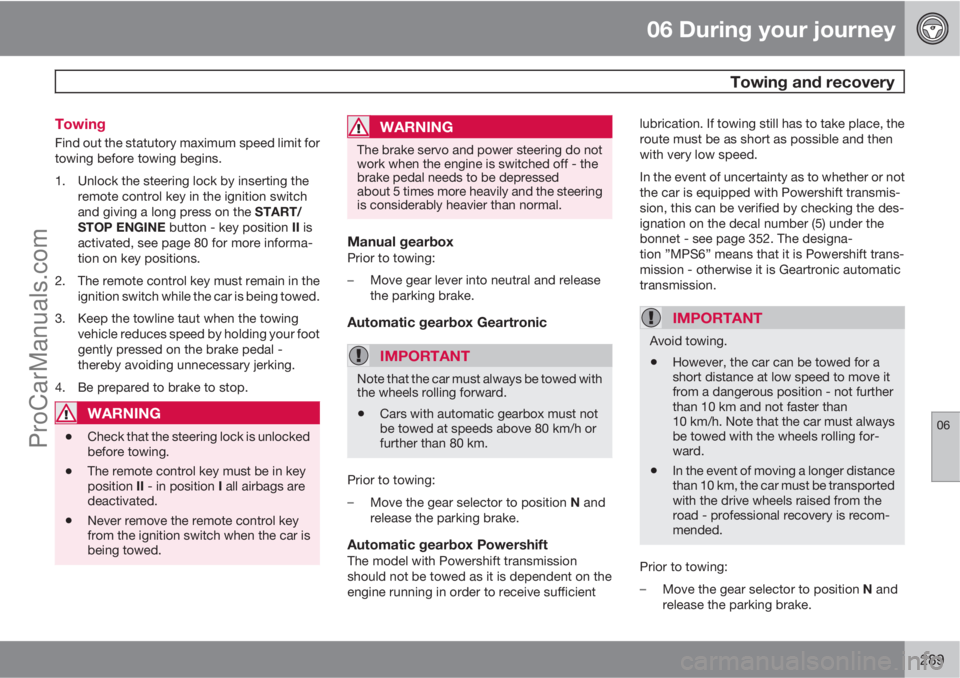
06 During your journey
Towing and recovery
06
289 Towing
Find out the statutory maximum speed limit for
towing before towing begins.
1. Unlock the steering lock by inserting the
remote control key in the ignition switch
and giving a long press on the START/
STOP ENGINE button - key position II is
activated, see page 80 for more informa-
tion on key positions.
2. The remote control key must remain in the
ignition switch while the car is being towed.
3. Keep the towline taut when the towing
vehicle reduces speed by holding your foot
gently pressed on the brake pedal -
thereby avoiding unnecessary jerking.
4. Be prepared to brake to stop.
WARNING
•Check that the steering lock is unlocked
before towing.
•The remote control key must be in key
position II - in position I all airbags are
deactivated.
•Never remove the remote control key
from the ignition switch when the car is
being towed.
WARNING
The brake servo and power steering do not
work when the engine is switched off - the
brake pedal needs to be depressed
about 5 times more heavily and the steering
is considerably heavier than normal.
Manual gearboxPrior to towing:
–Move gear lever into neutral and release
the parking brake.
Automatic gearbox Geartronic
IMPORTANT
Note that the car must always be towed with
the wheels rolling forward.
•Cars with automatic gearbox must not
be towed at speeds above 80 km/h or
further than 80 km.
Prior to towing:
–
Move the gear selector to position N and
release the parking brake.
Automatic gearbox PowershiftThe model with Powershift transmission
should not be towed as it is dependent on the
engine running in order to receive sufficientlubrication. If towing still has to take place, the
route must be as short as possible and then
with very low speed.
In the event of uncertainty as to whether or not
the car is equipped with Powershift transmis-
sion, this can be verified by checking the des-
ignation on the decal number (5) under the
bonnet - see page 352. The designa-
tion ”MPS6” means that it is Powershift trans-
mission - otherwise it is Geartronic automatic
transmission.
IMPORTANT
Avoid towing.
•However, the car can be towed for a
short distance at low speed to move it
from a dangerous position - not further
than 10 km and not faster than
10 km/h. Note that the car must always
be towed with the wheels rolling for-
ward.
•In the event of moving a longer distance
than 10 km, the car must be transported
with the drive wheels raised from the
road - professional recovery is recom-
mended.
Prior to towing:
–
Move the gear selector to position N and
release the parking brake.
ProCarManuals.com
Page 292 of 400
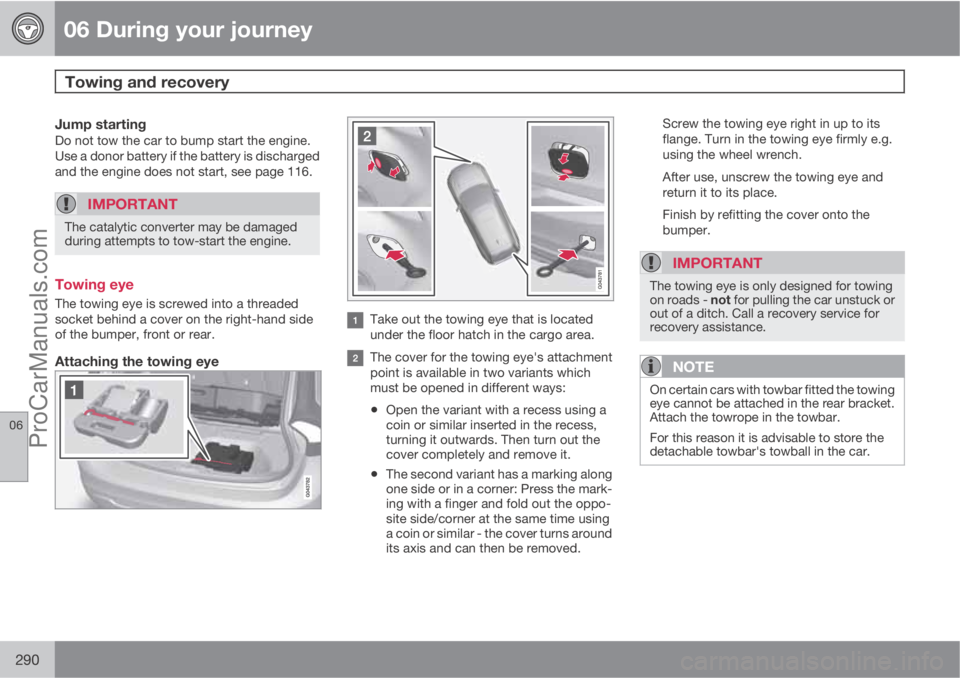
06 During your journey
Towing and recovery
06
290
Jump startingDo not tow the car to bump start the engine.
Use a donor battery if the battery is discharged
and the engine does not start, see page 116.
IMPORTANT
The catalytic converter may be damaged
during attempts to tow-start the engine.
Towing eye
The towing eye is screwed into a threaded
socket behind a cover on the right-hand side
of the bumper, front or rear.
Attaching the towing eye
Take out the towing eye that is located
under the floor hatch in the cargo area.
The cover for the towing eye's attachment
point is available in two variants which
must be opened in different ways:
•Open the variant with a recess using a
coin or similar inserted in the recess,
turning it outwards. Then turn out the
cover completely and remove it.
•The second variant has a marking along
one side or in a corner: Press the mark-
ing with a finger and fold out the oppo-
site side/corner at the same time using
a coin or similar - the cover turns around
its axis and can then be removed.Screw the towing eye right in up to its
flange. Turn in the towing eye firmly e.g.
using the wheel wrench.
After use, unscrew the towing eye and
return it to its place.
Finish by refitting the cover onto the
bumper.
IMPORTANT
The towing eye is only designed for towing
on roads - not for pulling the car unstuck or
out of a ditch. Call a recovery service for
recovery assistance.
NOTE
On certain cars with towbar fitted the towing
eye cannot be attached in the rear bracket.
Attach the towrope in the towbar.
For this reason it is advisable to store the
detachable towbar's towball in the car.
ProCarManuals.com
Page 293 of 400
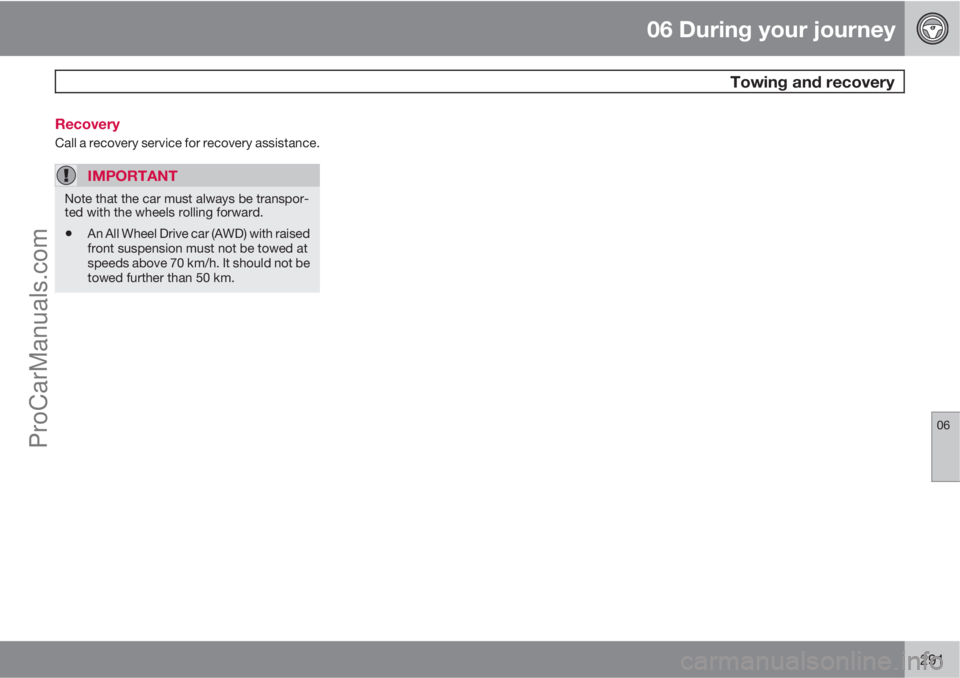
06 During your journey
Towing and recovery
06
291 Recovery
Call a recovery service for recovery assistance.
IMPORTANT
Note that the car must always be transpor-
ted with the wheels rolling forward.
•An All Wheel Drive car (AWD) with raised
front suspension must not be towed at
speeds above 70 km/h. It should not be
towed further than 50 km.
ProCarManuals.com
Page 294 of 400
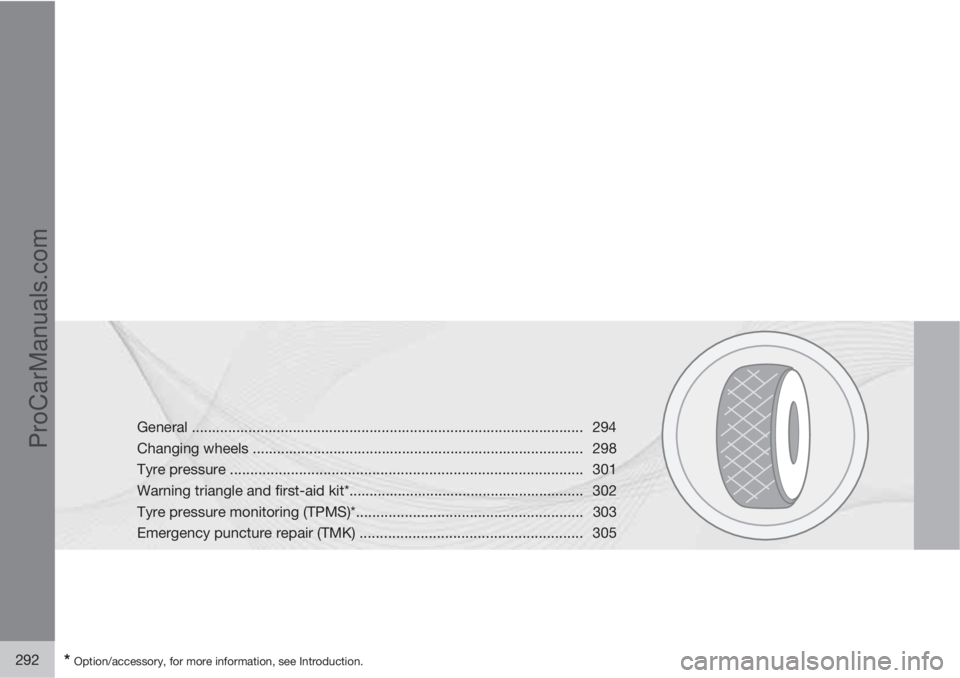
292* Option/accessory, for more information, see Introduction.
General ................................................................................................. 294
Changing wheels .................................................................................. 298
Tyre pressure ....................................................................................... 301
Warning triangle and first-aid kit*.......................................................... 302
Tyre pressure monitoring (TPMS)*........................................................303
Emergency puncture repair (TMK) ....................................................... 305
ProCarManuals.com
Page 295 of 400
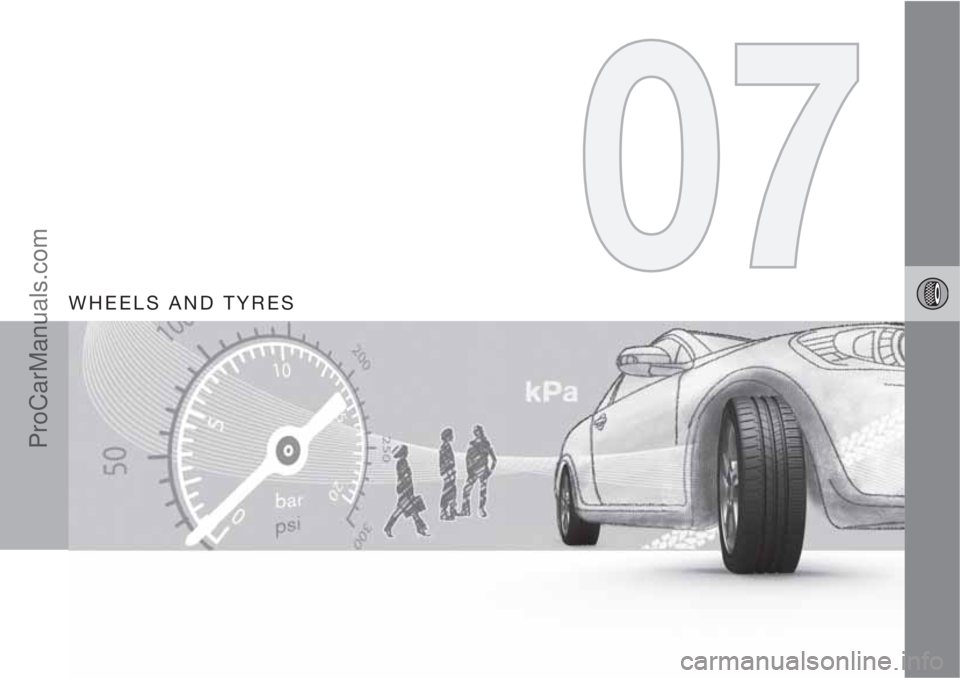
WHEELS AND TYRES
ProCarManuals.com
Page 296 of 400
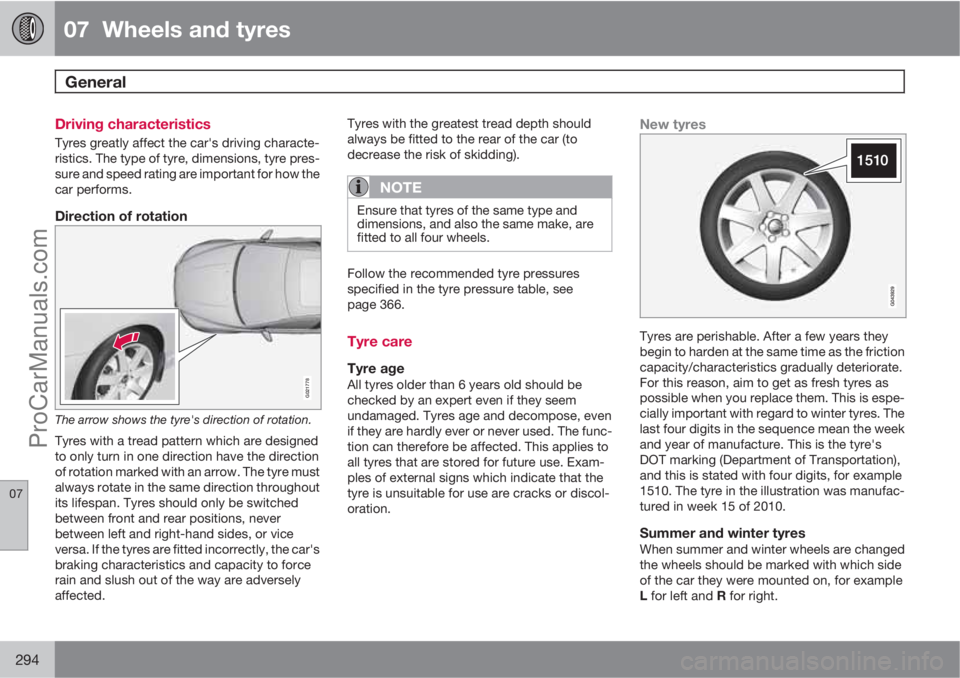
07 Wheels and tyres
General
07
294
Driving characteristics
Tyres greatly affect the car's driving characte-
ristics. The type of tyre, dimensions, tyre pres-
sure and speed rating are important for how the
car performs.
Direction of rotation
G021778
The arrow shows the tyre's direction of rotation.
Tyres with a tread pattern which are designed
to only turn in one direction have the direction
of rotation marked with an arrow. The tyre must
always rotate in the same direction throughout
its lifespan. Tyres should only be switched
between front and rear positions, never
between left and right-hand sides, or vice
versa. If the tyres are fitted incorrectly, the car's
braking characteristics and capacity to force
rain and slush out of the way are adversely
affected.Tyres with the greatest tread depth should
always be fitted to the rear of the car (to
decrease the risk of skidding).
NOTE
Ensure that tyres of the same type and
dimensions, and also the same make, are
fitted to all four wheels.
Follow the recommended tyre pressures
specified in the tyre pressure table, see
page 366.
Tyre care
Tyre ageAll tyres older than 6 years old should be
checked by an expert even if they seem
undamaged. Tyres age and decompose, even
if they are hardly ever or never used. The func-
tion can therefore be affected. This applies to
all tyres that are stored for future use. Exam-
ples of external signs which indicate that the
tyre is unsuitable for use are cracks or discol-
oration.
New tyres
Tyres are perishable. After a few years they
begin to harden at the same time as the friction
capacity/characteristics gradually deteriorate.
For this reason, aim to get as fresh tyres as
possible when you replace them. This is espe-
cially important with regard to winter tyres. The
last four digits in the sequence mean the week
and year of manufacture. This is the tyre's
DOT marking (Department of Transportation),
and this is stated with four digits, for example
1510. The tyre in the illustration was manufac-
tured in week 15 of 2010.
Summer and winter tyresWhen summer and winter wheels are changed
the wheels should be marked with which side
of the car they were mounted on, for example
L for left and R for right.
ProCarManuals.com
Page 297 of 400
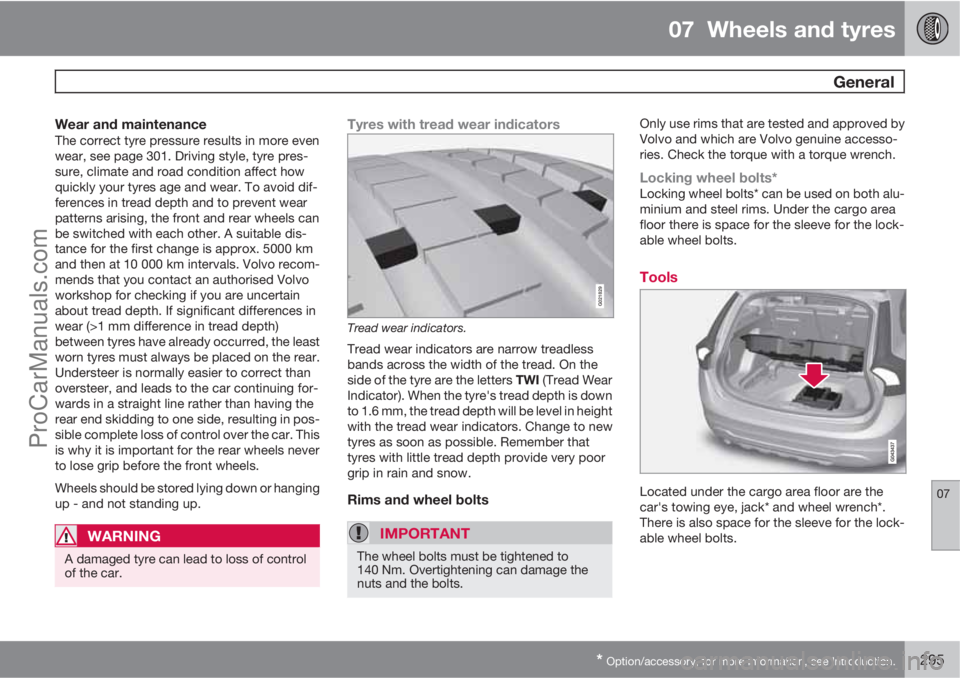
07 Wheels and tyres
General
07
* Option/accessory, for more information, see Introduction.295
Wear and maintenanceThe correct tyre pressure results in more even
wear, see page 301. Driving style, tyre pres-
sure, climate and road condition affect how
quickly your tyres age and wear. To avoid dif-
ferences in tread depth and to prevent wear
patterns arising, the front and rear wheels can
be switched with each other. A suitable dis-
tance for the first change is approx. 5000 km
and then at 10 000 km intervals. Volvo recom-
mends that you contact an authorised Volvo
workshop for checking if you are uncertain
about tread depth. If significant differences in
wear (>1 mm difference in tread depth)
between tyres have already occurred, the least
worn tyres must always be placed on the rear.
Understeer is normally easier to correct than
oversteer, and leads to the car continuing for-
wards in a straight line rather than having the
rear end skidding to one side, resulting in pos-
sible complete loss of control over the car. This
is why it is important for the rear wheels never
to lose grip before the front wheels.
Wheels should be stored lying down or hanging
up - and not standing up.
WARNING
A damaged tyre can lead to loss of control
of the car.
Tyres with tread wear indicators
G021829
Tread wear indicators.
Tread wear indicators are narrow treadless
bands across the width of the tread. On the
side of the tyre are the letters TWI (Tread Wear
Indicator). When the tyre's tread depth is down
to 1.6 mm, the tread depth will be level in height
with the tread wear indicators. Change to new
tyres as soon as possible. Remember that
tyres with little tread depth provide very poor
grip in rain and snow.
Rims and wheel bolts
IMPORTANT
The wheel bolts must be tightened to
140 Nm. Overtightening can damage the
nuts and the bolts.
Only use rims that are tested and approved by
Volvo and which are Volvo genuine accesso-
ries. Check the torque with a torque wrench.
Locking wheel bolts*Locking wheel bolts* can be used on both alu-
minium and steel rims. Under the cargo area
floor there is space for the sleeve for the lock-
able wheel bolts.
Tools
Located under the cargo area floor are the
car's towing eye, jack* and wheel wrench*.
There is also space for the sleeve for the lock-
able wheel bolts.
ProCarManuals.com
Page 298 of 400
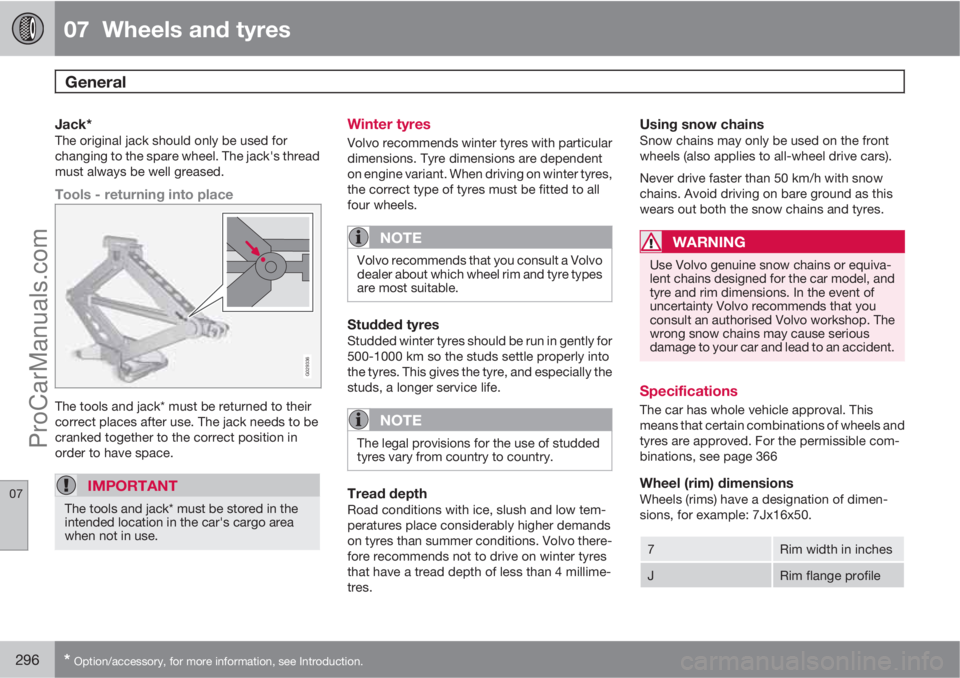
07 Wheels and tyres
General
07
296* Option/accessory, for more information, see Introduction.
Jack*The original jack should only be used for
changing to the spare wheel. The jack's thread
must always be well greased.
Tools - returning into place
G029336
The tools and jack* must be returned to their
correct places after use. The jack needs to be
cranked together to the correct position in
order to have space.
IMPORTANT
The tools and jack* must be stored in the
intended location in the car's cargo area
when not in use.
Winter tyres
Volvo recommends winter tyres with particular
dimensions. Tyre dimensions are dependent
on engine variant. When driving on winter tyres,
the correct type of tyres must be fitted to all
four wheels.
NOTE
Volvo recommends that you consult a Volvo
dealer about which wheel rim and tyre types
are most suitable.
Studded tyresStudded winter tyres should be run in gently for
500-1000 km so the studs settle properly into
the tyres. This gives the tyre, and especially the
studs, a longer service life.
NOTE
The legal provisions for the use of studded
tyres vary from country to country.
Tread depthRoad conditions with ice, slush and low tem-
peratures place considerably higher demands
on tyres than summer conditions. Volvo there-
fore recommends not to drive on winter tyres
that have a tread depth of less than 4 millime-
tres.
Using snow chainsSnow chains may only be used on the front
wheels (also applies to all-wheel drive cars).
Never drive faster than 50 km/h with snow
chains. Avoid driving on bare ground as this
wears out both the snow chains and tyres.
WARNING
Use Volvo genuine snow chains or equiva-
lent chains designed for the car model, and
tyre and rim dimensions. In the event of
uncertainty Volvo recommends that you
consult an authorised Volvo workshop. The
wrong snow chains may cause serious
damage to your car and lead to an accident.
Specifications
The car has whole vehicle approval. This
means that certain combinations of wheels and
tyres are approved. For the permissible com-
binations, see page 366
Wheel (rim) dimensionsWheels (rims) have a designation of dimen-
sions, for example: 7Jx16x50.
7Rim width in inches
JRim flange profile
ProCarManuals.com
Page 299 of 400
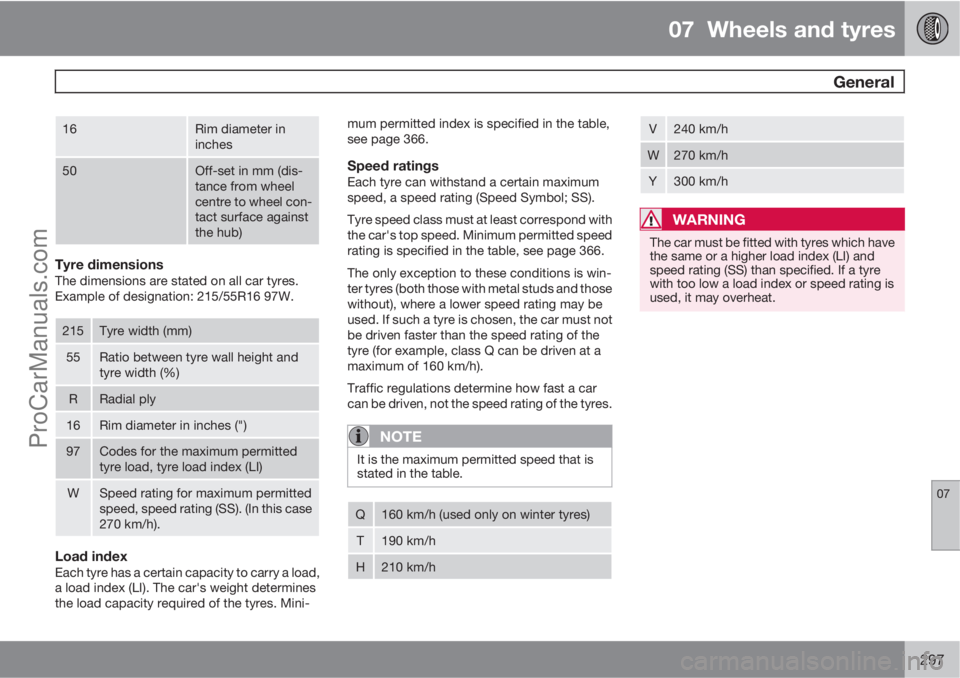
07 Wheels and tyres
General
07
297
16Rim diameter in
inches
50Off-set in mm (dis-
tance from wheel
centre to wheel con-
tact surface against
the hub)
Tyre dimensionsThe dimensions are stated on all car tyres.
Example of designation: 215/55R16 97W.
215Tyre width (mm)
55Ratio between tyre wall height and
tyre width (%)
RRadial ply
16Rim diameter in inches (")
97Codes for the maximum permitted
tyre load, tyre load index (LI)
WSpeed rating for maximum permitted
speed, speed rating (SS). (In this case
270 km/h).
Load indexEach tyre has a certain capacity to carry a load,
a load index (LI). The car's weight determines
the load capacity required of the tyres. Mini-mum permitted index is specified in the table,
see page 366.
Speed ratingsEach tyre can withstand a certain maximum
speed, a speed rating (Speed Symbol; SS).
Tyre speed class must at least correspond with
the car's top speed. Minimum permitted speed
rating is specified in the table, see page 366.
The only exception to these conditions is win-
ter tyres (both those with metal studs and those
without), where a lower speed rating may be
used. If such a tyre is chosen, the car must not
be driven faster than the speed rating of the
tyre (for example, class Q can be driven at a
maximum of 160 km/h).
Traffic regulations determine how fast a car
can be driven, not the speed rating of the tyres.
NOTE
It is the maximum permitted speed that is
stated in the table.
Q160 km/h (used only on winter tyres)
T190 km/h
H210 km/h
V240 km/h
W270 km/h
Y300 km/h
WARNING
The car must be fitted with tyres which have
the same or a higher load index (LI) and
speed rating (SS) than specified. If a tyre
with too low a load index or speed rating is
used, it may overheat.
ProCarManuals.com
Page 300 of 400
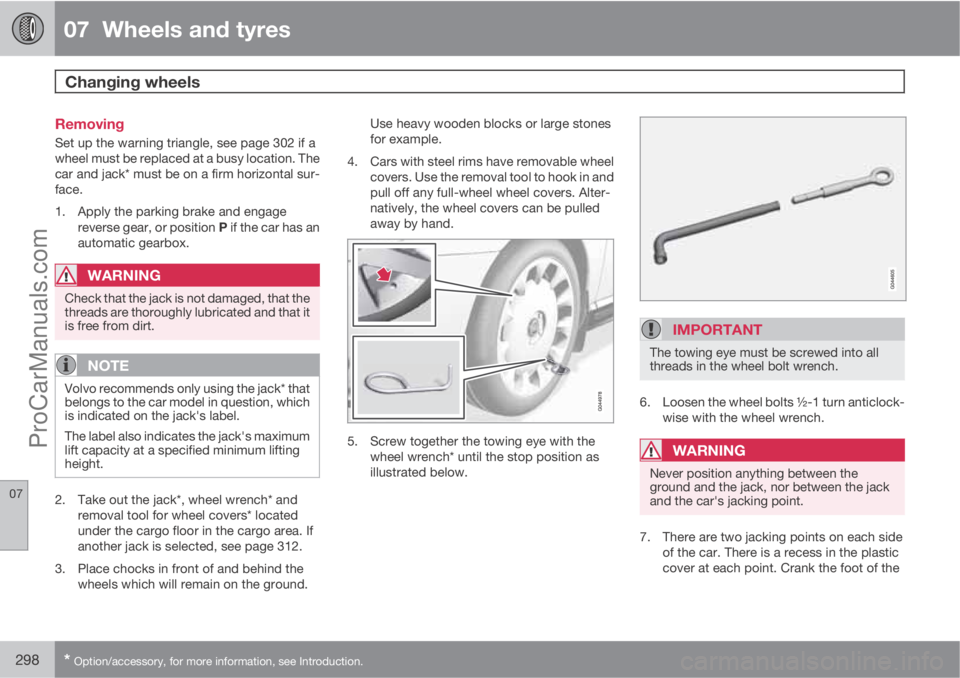
07 Wheels and tyres
Changing wheels
07
298* Option/accessory, for more information, see Introduction.
Removing
Set up the warning triangle, see page 302 if a
wheel must be replaced at a busy location. The
car and jack* must be on a firm horizontal sur-
face.
1. Apply the parking brake and engage
reverse gear, or position P if the car has an
automatic gearbox.
WARNING
Check that the jack is not damaged, that the
threads are thoroughly lubricated and that it
is free from dirt.
NOTE
Volvo recommends only using the jack* that
belongs to the car model in question, which
is indicated on the jack's label.
The label also indicates the jack's maximum
lift capacity at a specified minimum lifting
height.
2. Take out the jack*, wheel wrench* and
removal tool for wheel covers* located
under the cargo floor in the cargo area. If
another jack is selected, see page 312.
3. Place chocks in front of and behind the
wheels which will remain on the ground.Use heavy wooden blocks or large stones
for example.
4. Cars with steel rims have removable wheel
covers. Use the removal tool to hook in and
pull off any full-wheel wheel covers. Alter-
natively, the wheel covers can be pulled
away by hand.
5. Screw together the towing eye with the
wheel wrench* until the stop position as
illustrated below.
IMPORTANT
The towing eye must be screwed into all
threads in the wheel bolt wrench.
6. Loosen the wheel bolts ½-1 turn anticlock-
wise with the wheel wrench.
WARNING
Never position anything between the
ground and the jack, nor between the jack
and the car's jacking point.
7. There are two jacking points on each side
of the car. There is a recess in the plastic
cover at each point. Crank the foot of the
ProCarManuals.com